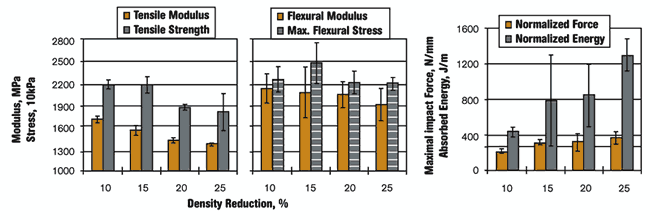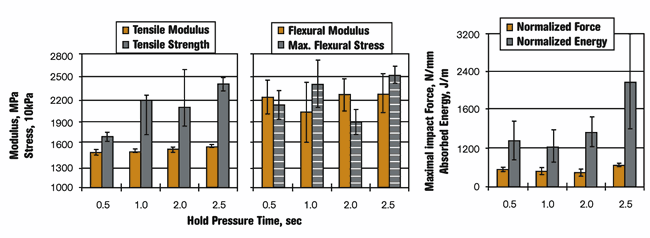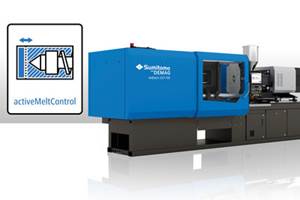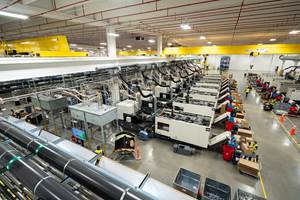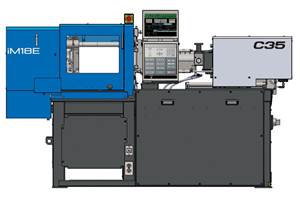New Light on How to Optimize Properties of Microcellular Foams
With the growing popularity of thermoplastic microcellular foams (such as those produced by the MuCell process of Trexel Inc.) comes increased need to understand how to optimize foam properties through appropriate foam structure.
With the growing popularity of thermoplastic microcellular foams (such as those produced by the MuCell process of Trexel Inc.) comes increased need to understand how to optimize foam properties through appropriate foam structure. Previous research has illuminated the relationships between processing and cell structure. The unsolved problem is to correlate cell structure with foam mechanical properties. Answers to the latter would ultimately enable a manufacturer to tailor a process for the desired end use.
Achieving this synthesis is the goal of a team of engineering graduate-student researchers at the Institute of Plastics Processing (IKV) in Aachen, Germany. Laura Florez, a member of that team, presented their latest results at this spring’s SPE ANTEC meeting in Milwaukee. Though microcellular foam work is ongoing at the IKV, results so far already suggest some guidelines on how processors can improve their foam parts. As Florez reported in Milwaukee, the key is controlling the foam cell morphology—average cell size and cell-size distribution. “With the same material consumption, a reduction in the mean cell diameter can improved tensile strength up to 35% without significant influence on the elastic modulus,” she stated.
CELL-STRUCTURE CONTROL
The IKV team explored the effects of foam density, skin thickness, and cell-size distribution on tensile, flexural, and impact properties. In the IKV lab, they injection molded polycarbonate plaques of 200 x 100 x 3 mm. Before molding, PC pellets were preloaded with nitrogen gas in an autoclave filled with pure nitrogen at 70 bar (1015 psi), where they were held for 14 hr at room temperature. (In actual microcellular foam production, the gas is typically injected into the machine barrel, though a new process is being developed at the IKV for pressurizing the press hopper with nitrogen.)
Molding experiments were performed with a mold having a moving core to create a cavity that was expandable after initial injection. The mold was first filled with the core forward at a variable position. After a holding period to form the frozen skin, the core was retracted to expand the cavity to its maximum 3-mm thickness, allowing foaming in the part’s molten center.
The researchers manipulated three variables: length of core movement, speed of core movement, and hold time before core movement. One variable was changed at a time while the others were held constant.
- Varying the distance of core travel allowed for different amounts of expansion of the molten center of the part, resulting in different densities of the foamed core of the part. (Several molders are working to use an expanding mold cavity with the MuCell process.)
- Varying the hold time before foam expansion changed the thickness of solid skin formed on the part. (In fact, the skin thickness varied somewhat in all these experiments, even when it was not the intended variable.)
- Varying the speed of movement of the mold core changed the cell-size distribution in the resulting foam.
After molding, samples were sliced and polished for viewing under a microscope.
EFFECT OF DENSITY
Density reduction in these experiments ranged from 10% to 25%. For parts with the same skin thickness and different core density, lower density resulted in fewer and bigger cells. This correlated with lower tensile strength and modulus, though the correlation with flexural properties was less clear and less pronounced (Fig. 1). An interesting result was higher tensile elongation and mich higher instrumented multi-axial impact toughness at lower densities. Both the force required to break the part and the energy absorbed were greater with increased cell formation, even at very low levels of density reduction.
EFFECT OF SKIN THICKNESS
Longer hold time produced finer and more uniform cells with the same degree of density reduction (mold cavity expansion) in the part’s core. However, the target variable, skin thickness was only slightly affected. Finer cells correlated with higher tensile strength, but there was no significant change in tensile modulus (Fig. 2). Flexural properties showed no clear trend. But tensile elongation and impact energy absorption increased dramatically at the highest hold time, which produced a proportionally thicker skin and extremely fine cells.
EFFECT OF CELL SIZE
Keeping the nominal skin thickness and core density reduction the same, and varying only the speed of cavity expansion produced more and finer cells at faster expansion rates (Fig. 3). While the tensile modulus was unaffected, tensile strength increased 50% with a finer cell structure. Effects on flexural properties were smaller and the trend was less clear. But impact energy absorption increased almost three-fold with a finer cell structure.
ONGOING RESEARCH
Florez noted that these experiments varied the skin thickness by only 8%. To achieve a greater thickness variation, the IKV team is now combining a reduction in mold temperature with longer hold time. This appears not to affect cell size. Confirming the previous studies, early results with this technique show higher tensile strength and modulus with larger increases in skin thickness.
Florez concluded that not just foam density, but also foam cell morphology significantly affects part properties. However, the effect of foam morphology also depends on the type of loading of the part—tensile, flexural, or impact. For example, density reduction substantially diminishes tensile properties but is less critical if the part is exposed primarily to impact loads.
In addition, Florez and her co-authors noted, “Not all morphological parameters can be optimized simultaneously. It is necessary to determine the relevance of each one for each loading condition.” The IKV researchers plan to explore simultaneous correlation of multiple variables to determine their relative weights in determining cell morphology and part properties. “In this way, the variables with higher influence can be identified and optimized to improve mechanical performance,” they stated.
Related Content
50 Years...600 Issues...and Still Counting
Matt Naitove marks his first half-century in plastics reporting, with a few of his favorite headlines.
Read MoreAdaptive, Automatic Process Control for Injection Molding
Sumitomo (SHI) Demag says its activeMeltControl for all new IntElect 2 machines can automatically compensate for shot-weight variations.
Read MoreIPEX Opens Injection Molding Facility in North Carolina
The pipe and fittings manufacturer’s new 200,000-square-foot facility represents a $200 million investment and will create 150 jobs.
Read MoreCompact Hybrid Injection Molding Machine Launched
Sumitomo Heavy Industries Ltd. (SHI) has introduced the iM18E, promising the smallest footprint in 20-ton machines.
Read MoreRead Next
Advanced Recycling: Beyond Pyrolysis
Consumer-product brand owners increasingly see advanced chemical recycling as a necessary complement to mechanical recycling if they are to meet ambitious goals for a circular economy in the next decade. Dozens of technology providers are developing new technologies to overcome the limitations of existing pyrolysis methods and to commercialize various alternative approaches to chemical recycling of plastics.
Read MoreTroubleshooting Screw and Barrel Wear in Extrusion
Extruder screws and barrels will wear over time. If you are seeing a reduction in specific rate and higher discharge temperatures, wear is the likely culprit.
Read MorePeople 4.0 – How to Get Buy-In from Your Staff for Industry 4.0 Systems
Implementing a production monitoring system as the foundation of a ‘smart factory’ is about integrating people with new technology as much as it is about integrating machines and computers. Here are tips from a company that has gone through the process.
Read More




